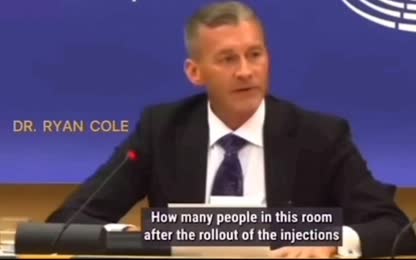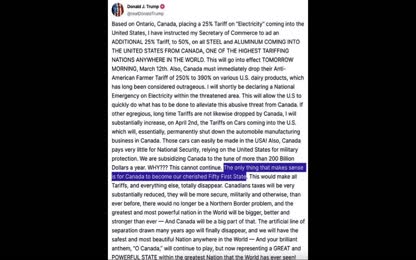Advertisement
Coronavirus Outbreak Wuhan China WHO Emergency Epidemic Quarantines
Coronavirus Outbreak Wuhan China WHO Emergency Epidemic Quarantines
- Category: Alarmism / Alarmist,Official Facts /Official Story,Bio Weapon/Biological Warfare,Virus / Bacteria / Sickness
- Duration: 45:49
- Date: 2020-02-01 09:15:28
- Tags: coronavirus outbreak wuhan china epidemic quarantine
6 Comments
Video Transcript:
Today, the greatest risk of global catastrophe doesn't look like this. Instead, it looks like this. If anything kills over 10 million people in the next few decades, it's most likely to be a highly infectious virus rather than a war. There's one thing that consistently ranks as one of the most likely things to end the world. Well, if you think of anything that could come along that would kill millions of people, the pandemic is our greatest risk. A pandemic is a disease that escapes our control, sweeping across the world, killing millions and changing civilizations. We know this because we've seen it before. A few times. A hundred years ago, a deadly influenza virus infected hundreds of millions of people somewhere in the order of 50 to 100 million deaths. When we talk about another flu pandemic happening, it's not a matter of if, but when. A new strain, our food. This is definitely one of the most lethal influenza viruses that we have seen so far. It just takes one person to start an outbreak. It will lead its mark. The result would be hundreds of millions of people that would likely die. That's why I do what I do. We're making a vaccine that could treat all future versions of flu. This vaccine could eradicate influenza as we know it. We are in charge of our children. The problem so widespread, the World Health Organization, is calling the refusal to vaccinate one of the biggest threats of 2019. A healthy child has the ability to build a community naturally. I know that what I do is important to my patients, but what am I doing to myself and my family? Within one month, the virus can spread throughout the country. A month after that, widespread throughout the world. The next pandemic is going to start. We just don't know where or how, but we know it will. That poses an existential threat to us as a species. The virus is going to be a very important thing. We are going to have a lot of fun. We are going to have a lot of fun. We are going to have a lot of fun. We are going to have a lot of fun. We are going to have a lot of fun. We are going to have a lot of fun. Just have fun. How long will you stay engaged? If you are new to this world, então what should I say? It is what I do. Doppity Director of the Johns Hopkins Center for Health Security. And today I will be your master of ceremonies for event 201. On behalf of our center and our partners, the World Economic Forum and the Bill and the Millenn Gates Foundation, I'd like to extend a very warm welcome to our audience here in New York, as well as our larger virtual audience participating online today. The goal of the event 201 exercise is to illustrate the potential consequences of a pandemic and the kinds of societal and economic challenges it would pose. The scenario also highlights the very critical role that global business and public private partnerships play in preparing for and responding to pandemics. Today's scenario is going to simulate meetings of a multi-stakeholder group called the Pandemic Emergency Board. This board has been urgently convened by the World Economic Forum. And Johns Hopkins has been asked to moderate the board meetings and provide expertise during the board's deliberations. The mission of the Pandemic Emergency Board is to provide recommendations to deal with a major global challenges arising in response to an unfolding pandemic. In other words, we've created a pandemic that could realistically occur. It began in healthy looking pigs months perhaps years ago. A new coronavirus spread silently within her. Gradually, farmers started getting sick. Infected people got a respiratory illness with symptoms ranging from mild flu-like signs to severe pneumonia. The sickest required intensive care many died. Experts agree, unless it is quickly controlled, it could lead to a severe pandemic, an outbreak that circles the globe and affects people everywhere. The mission of the Pandemic Emergency Board is to provide recommendations to deal with a major global challenges arising in response to an unfolding pandemic. The board is comprised of highly experienced leaders from business, public health, and civil society. We could be looking at double the number of cases in one week and 16 times as many in a month if we are not able to stop the spread. That would be on the order of half a million cases and it would continue to rise exponentially. In three months, we could be approaching 10 million cases. We are at the start of what is looking like. It will be a severe pandemic. There are problems emerging that can only be solved by global business and governments working together. Thank you for this opportunity to say a few words at this year's event, the 201, the high-level simulation exercise for pandemic preparedness in response hosted by John Hopkins Center for Health Security, the World Economic Forum, and the Bill and the Gates Foundation. Unfortunately, I was not able to join you today. I'm involved in the IHR Emergency Committee for Ebola, but I had hoped to be in the room with you because the issues you will be dealing with over the next hours may be tabled up exercises today, but they address real and critical threats which we at WHO take very seriously. Without a question, epidemic risk has become a global strategic concern. I don't think we've ever been in a situation where we have had to respond to so many health emergencies at once. This is a new normal. I don't expect the frequency of these epidemics to reduce and in fact vulnerabilities all over the world, developed and developing countries have increased, not decreased, driven by many, many factors mainly through human behavior, economic development, population density, and many others. The scenario you will be presented with this morning could easily become one shared reality one day, could easily become one shared reality one day, shared reality one day. Creating a problem, waiting for the reaction, and then offering a solution, a solution that was decided upon before the problem was ever created. This is known as the Hagelean Dialectic. A shared reality. A shared reality. A shared reality. A shared reality. To mitigate the impact on populations most at risk. The Global Outbreak Alert and Response Network was created in 2000 in the aftermath of a number of outbreak responses where WHO and multiple partners were in the field together. But lacking the necessary coordination to make those events as operational and successful as they could be, we noticed a lot of shortcomings. We needed to bring the organizations together to plan an advance of these large deployments. We needed to bring the organizations together to plan an advance of these large deployments. We needed to bring the organizations together. The Global Outbreak Alert and Response Network The Global Outbreak Alert and Response Network The Global Outbreak Alert and Response Network The Global Outbreak Alert and Response Network The Global Outbreak Alert and Response Network The Global Outbreak Alert and Response Network The Global Outbreak Alert and Response Network The Global Outbreak Alert and Response Network The Global Outbreak Alert and Response Network Over the past few weeks, we have witnessed the emergence of a previously unknown pathogen which has escalated into an unprecedented outbreak. There are now 98 cases in 18 countries outside China. I'm declaring a public health emergency of international concern over the global outbreak of novel coronavirus. It will help a truly loved country in this region. Thank you so much. Good evening and thanks for joining us. We begin with news about the new coronavirus outbreak. The World Health Organization has now declared it an international public health emergency. Its concerned countries with weak healthcare systems may not be able to cope. The WHO stressed 99% of cases are in China and it praised that country's response. The numbers, though, keep rising. Chinese authorities are reporting more than 9400 confirmed cases worldwide. The vast majority are in China and there are thousands more suspected cases. Every province in mainland China now has confirmed cases. On this map, the darker the red, the higher the number. Wuhan, the capital of Hubei province, where this outbreak began, has the most over 1,000 cases. 213 people have now died from this new strain of coronavirus. All of them are in China and the WHO says China, which has put millions of people under quarantine and is rapidly building new hospitals to handle all the sick people, has set a new standard for outbreak response. I have never seen in my life this kind of mobilization the measures they're taking, which I believe will reverse the tide. But not only what they're doing is protecting their people, but I know from the figures also, you know that it's protecting the rest of the world. 213 people have now died from this new strain of coronavirus. All of them are in China. All of them are in China. All of them are in China. We'll get afternoon, everyone. I'm Alex A. Z. Our Secretary of Health and Human Services and chairman of the President's Task Force on the novel Corona Virus. Beginning at 5 p.m. Eastern Standard Time Sunday, February the 2nd. The United States government will implement temporary measures to increase our abilities to detect and contain the coronavirus proactively and aggressively. Any U.S. citizen returning to the United States, who has been in Hu Bay province in the previous 14 days, will be subject to up to 14 days of mandatory quarantine to ensure they've provided proper medical care and health screening. To be clear, this applies only to U.S. citizens who have been in Hu Bay province in the past 14 days prior to their attempted entry into the United States. Any U.S. citizen returning to the United States who has been in the rest of mainland China within the previous 14 days will undergo proactive entry, health screening at a select number of ports of entry and up to 14 days of monitored self-quarantine to ensure they've not contracted the virus and do not pose a public health risk. Additionally, the President has signed a presidential proclamation using his authority pursuant to section 212F of the Immigration and Nationality Act, temporarily suspending the entry into the United States of foreign nationals who pose a risk of transmitting the 2019 novel coronavirus. As a result, foreign nationals, other than immediate family of U.S. citizens and permanent residents who have traveled in China within the last 14 days will be denied entry into the United States for this time. Once again, these actions will become effective at 5 p.m. Eastern Standard Time Sunday, February 2. These prudent, targeted, and temporary actions will decrease the pressure on public health officials screening incoming travelers, expedite the processing of U.S. citizens' and permanent residents returning from China and ensure resources are focused on the health and safety of the American people. I want to stress, the risk of infection for Americans remains low, and with these and our previous actions, we are working to keep the risk low. Let me next invite the Acting Deputy Secretary of the Department of Homeland Security, Ken Kuchenelli, to take the podium for some comments. Thank you, Mr. Secretary. I am Ken Kuchenelli and the Acting Deputy Secretary of the Department of Homeland Security, and in the department's representative on the task force led by Secretary Azar. Several elements of the Department of Homeland Security are engaged in implementing the medical strategy you heard described here, including Customs Border Protection, which stands at our land ports, seaports, and airports, and I'll come back to the airports in a moment, particularly the Office of Field Operations personnel who you see when you come back into the country from your travels. They're the first line of defense when you land and come to the country. Homeland engagement is TSA, the security and the engagement with the airlines. Our chief medical officer in the department is in CWMD, and we're providing medical support at the airports. So we're using contract authority that we have to backfill the CDC personnel so they can be freed up for other missions at the airports where medical screening is being focused. FEMA continues to prepare and support HHS preparations themselves, and then the United States Coast Guard, of course, commands the ports of the United States and deals with incoming shipping, which is obviously slower than the airplanes, but coming nonetheless, and we're prepared to deal with each of those. The President's proclamation will have Customs Border Protection ensuring that United States citizens, legal permanent residents, and their immediate families continue to enter the United States, though they, those coming from who I province, as you heard from the Secretary, will be subject to quarantine and the others from China to screening. We will be implementing a funneling effort at the airports. This is done under the authority of the Customs Border Protection, and it will include seven airports. So starting five o'clock on Sunday, Eastern time, incoming flights from China will be funneled through seven airports. Those airports are JFK, Chicago's O'Hare in San Francisco, Seattle, Atlanta, Honolulu, and LAX. This is done under CBP's authority. We'll be executed by the Secretary of the Department of Homeland Security, consistent with the President's proclamation and in support of that effort, again, so we can focus the expertise of the medical professionals that will do the screening to implement this. We'll continue to support the medical efforts across the country, both at our ports, our land, sea, and air, as well as with personnel standing up some of the resiliency measures that HHS has been working on for some time. Thank you. Kevin, would you like to start it? Thank you, Mr. Secretary. If the risk is really low, could you talk about why go to such an extreme as a public health emergency? If the risk is that low, why are we taking such measures? What in the...? So these are actually fairly incremental, measured steps on top of the steps we've already progressively been taking. You'll notice that many airlines have already stopped direct flights from China, have pulled that down. We're seeing a significant... The Department of Transportation could comment on the numbers we're seeing are Homeland Security. We've seen a significant reduction in people from the U.S. going to China, people from China coming to the U.S. already. This just helps us focus our efforts so that we, as we're dealing with the unknowns that Dr. Fauci spoke about earlier, unknowns around incubation period, unknowns about the speed of transmissibility, unknowns about asymptomatic transmission, unknowns about severity, that we take appropriate measured, prudential steps so we can focus our resources because it's the bread and butter I've talked to you before about the bread and butter of public health is identify people who might be symptomatic or might have the disease, diagnose, isolate, treat, contact trace. That's a significant undertaking as we have already done with the six individuals in the United States who've been positively identified. We have to focus those resources. John? Secretary of the mandatory quarantine for people coming in and who may province, will that be home quarantine or will that be in an institutional setting? That would be at an appropriate quarantine facility of some kind for those individuals. For the U.S. citizens returning to the United States from having been in China within the previous 14 days, they would be funneled as Secretary Kuchinelli spoke of, they would be screened appropriately to see if they present any type of symptoms of the disease. And then they would be asked to self-isolate at home over the 14 days. But for individuals from Hubei, because that is the epicenter of this with such high immediate transmission, we filled these additional measures of quarantine for up to 14 days are appropriate. How, how? Hey, could I just follow that? Have you selected specific quarantine centers? We have selected them. We will announce those as DHS implements with the airlines that funneling activity. Thank you. Thank you. The best of all, John. What does self-quarantine look like for the people who are self-quarantining? How do you enforce that, what are the mechanisms surrounding that? And could also speak to you just describe this as sort of incremental step. I believe this is obviously significant, the quarantine of citizens in this country. What is your message to Americans who are watching us on the news, who are seeing this, who are feeling really alarmed by this next administration is taking a bite of spread coronavirus in general. They hear you say the risk is low, but then they see this action being taken and I think some people might be freaked out by that. I hope not. I hope that people will see that their government is taking responsible steps to protect them. These are preventive steps. The risk is low in the United States. The risk is low. Of transmissibility, the risk of contracting the disease is low. But our job is to keep that risk low as much as we can by taking appropriate preventative steps. So that's the approach we're taking. Let me ask Dr. Redfield if he can talk a bit about we, this is, we do this type of quarantine and self isolation work basically every day. Working very closely. I want to stress something that we've not mentioned enough. Working very closely with our state and local public health partners there. Just as we do with emergency response, we serve as a backup and expertise and a border type force. But the state and local authorities are the backbone of our public health infrastructure and we work with them daily to help with our quarantine stations. And any U.S. citizen returning to the United States who has been in the rest of mainland China within the previous 14 days will undergo proactive entry health screening at a select number of ports of entry and up to 14 days of monitored self quarantine to ensure they've not contracted the virus and do not pose a public health risk. Every province in mainland China now has confirmed cases on this map to darker the red, the higher the number. Wuhan, the capital of Hubei province where this outbreak began has the most over 1000 cases. 213 people have now died from this new strain of coronavirus. All of them are in China. 213 people have now died from this new strain of coronavirus. All of them are in China. China is huge. The kind of huge that's hard to wrap your head around. Beginning in the 1950s, its population exploded from an already respectable 500 million to almost three times that today, which makes it bigger than all of North America, Australia and Europe combined. So for every one person living in the USA, there's about 4.6 people living in China. Is that making that massive population the most densely populated country in the world? No, not by a long shot. It's the very smallest countries that have the densest populations. China has a population density of roughly 375 per square mile or 145 per square kilometer. While in 2014 Hong Kong, which is part of China but still an autonomous territory, had a population density of a whopping 6,690 people per square kilometer. In the UK, it's much more densely populated than China, which is only the 59th most densely populated country in the world. The USA is actually one of the most spacious countries out there and comes in at 146th on the list. Any US citizen returning to the United States, who has been in the rest of mainland China within the previous 14 days, will undergo proactive entry health screening at a select number of reports of entry and up to 14 days of monitored self-quarantine. Of monitored self-quarantine. I'm going to show you how to find the probability using words and fractions. First of all, probability tells us the likelihood that an event is going to happen. Let's do an example where we have a bag of beads, say it has 20 beads in it. And two of them are red, maybe four are white. The probability that we're going to pull a red bead, we just randomly reach in and pull a bead out, is we have two red beads that we can pick. We want either one of them. But we have a total of 20 beads. So our probability, 20 red over 20 beads is just two over 20, which simplifies to one 10th. That's our probability. In the probability that we'll choose white, four white over the 20 total count gives us four over 20 or a one in five chance of pulling out a white bead. We're going to show you how to find the probability using words and fractions. First of all, probability tells us the likelihood that an event is going to happen. Let's do an example where we have a bag of beads, say it has 20 beads in it. And two of them are red, maybe four are white. The probability that we're going to pull a red bead. We just randomly reach in and pull a bead out, is we have two red beads that we can pick. We want either one of them. But we have a total of 20 beads. So our probability, 20 red over 20 beads is just two over 20, which simplifies to one 10th. That's our probability. In the probability that we'll choose white, four white over the 20 total count gives us four over 20 or a one in five chance of pulling out a white bead. Breaking news tonight. The coronavirus declared a public health emergency in the US. The domestic new measures up to 14 days of mandatory quarantine for any American traveling from the outbreak epicenter in China for nationals who are deemed a risk barred from entering the country. Tonight the new case confirmed in the US, major US airlines suspending all flights to China as fears rise of a global pandemic, what you need to know. We're going to show you how to find the probability using words and fractions. First of all, probability tells us the likelihood that an event is going to happen. Let's do an example where we have a bag of beads, say it has 20 beads in it. And two of them are red, maybe four are white. The probability that we're going to pull a red bead. We just randomly reach in and pull a bead out is we have two red beads that we can pick. We want either one of them. But we have a total of 20 beads. So our probability, 20 red over 20 beads is just two over 20, which simplifies to one 10th. That's our probability. And the probability that we'll choose white for white over the 20 total count gives us four over 20 or a one in five chance of pulling out a white bead. Tech and contain the corona virus proactively and aggressively. Committee, U.S. citizen returning to the United States, who has been in who bay province in the previous 14 days will be subject to up to 14 days of mandatory quarantine to ensure they've provided proper medical care and health screening or teen days of mandatory quarantine, 14 days of mandatory quarantine. And the mighty Yangtze, with a mighty 3500 years of history. Now this is Wuhan, the cultural, political, economic, educational and transportation hub of Central China. It's known as Julesheng, Tengcheng, which means the thoroughfare of nine provinces. And it's also repairing gateway to the rest of the world. And because of that, it's an extraordinary city with an extraordinary character. My name is Zoe, you're watching Travel Log, and this is Wuhan. Wuhan is the capital of Hubei Province. With a population of 10.7 million, it's a booming megalopolis lying at the confluence of the Yangtze River and its longest tributary, the Hunchang. Five and a half hours on a high-speed train from Beijing, and you'll find yourself swept up in the ancient, yet futherly beating heart of the country. Because of its pivotal role in domestic transport, Wuhan has been nicknamed the Chicago of China. I'm going to show you how to find the probability using words and fractions. First of all, probability tells us the likelihood that an event is going to happen. Let's do an example where we have a bag of beads, let's say it has 20 beads in it. And two of them are red, maybe four are white. The probability that we're going to pull a red bead, we just randomly reach in and pull a bead out, is we have two red beads that we can pick. We want either one of them. But we have a total of 20 beads. So our probability, 20 red over 20 beads, is just two over 20, which simplifies to one tenth. That's our probability. Then the probability that we'll choose white, four white over the 20 total count, gives us four over 20 or a one in five chance of calling out a white bead. The U.S. citizens traveling from ground zero of the outbreak in China now subject to mandatory quarantine. It comes as a seventh case was confirmed in the U.S. this time in Northern California. Miguel Elmagear starts us off. Tonight is the death toll climbs in the number of coronavirus cases explodes. The U.S. government taking a rare step, declaring a public health emergency in the United States. Beginning at 5 p.m. Sunday February the second. The United States government will implement temporary measures to detect and contain the coronavirus. Those measures include closing the U.S. border to nearly all foreign nationals who have traveled through China in the last two weeks. They've also imposed a 14-day mandatory quarantine for any U.S. citizen who has been to the epicenter in the previous 14 days. This includes the 195 U.S. citizens who evacuated Wuhan now at March Air Reserve Base. The CDC warning, even individuals who have been exposed and tested negative could still develop symptoms and become contagious later. With the State Department issuing a level four do not travel advisory for all of China, American Airlines, United and Delta are suspending operations there. I'm declaring a public health emergency of international concern over the global outbreak of novel coronavirus. Beginning at 5 p.m. Eastern Standard Time Sunday February the second. The United States government will implement temporary measures to increase our abilities to detect and contain the coronavirus proactively and aggressively. The UK and France also flying emergency charters, as Australia plans to quarantine its evacuees on an island 1600 miles from shore. The 14-day mandatory quarantine that's been issued at this military base is an extreme measure that we haven't seen in decades. The last time we saw a scare like this was for smallpox some 50 years ago. Lester? Miguel Almaguer, thanks NBC's Tom Castello joins us now with dullest airport outside Washington. Tom Fifty Airlines globally are now suspending flights to China. Have we ever seen anything quite like that scale? You know airlines have cancel flights before due to political instability or even violence. But these cancellations do seem to surpass evil we saw during the SARS outbreak in 2003. Earlier today the largest flight attendant's union called for a total ban on flights. So here's where we stand right now. Hurricane airline has already canceled flights through March. United's last flight next week also through the end of March. Delta canceling flights all the way through April. Now the airlines say this is really out of an abundance of caution following State Department guidance, Lester. Part of that growing impact from this dangerous virus, Tom. Thank you. Today the greatest risk of global catastrophe doesn't look like this. Instead it looks like this. If anything kills over 10 million people in the next few decades, it's most likely to be a highly infectious virus rather than a war. Not missiles but microbes. Now part of the reason for this is that we have invested a huge amount in nuclear deterrence. But we've actually invested very little in a system to stop an epidemic. We're not ready for the next epidemic. Let's look at Ebola. I'm sure all of you read about it in the newspaper. Lots of tough challenges. I followed it carefully through the case analysis tools we used to track polio eradication. And as you look at what went on, the problem wasn't that there was a system that didn't work well enough. The problem was that we didn't have a system at all. In fact, there are some pretty obvious key missing pieces. We didn't have a group of epidemiologists ready to go who would have gone, seen what the disease was, see how far it had spread. The case reports came in on paper. I was very delayed before they were put online and they were extremely inaccurate. We didn't have a medical team ready to go. We didn't have a way of preparing people. Now medicine, some frontiers did a great job orchestrating volunteers. But even so, we were far slower than we should have been getting the thousands of workers into these countries. And a large epidemic would require us to have hundreds of thousands of workers. There was no one there to look at treatment approaches. No one to look at the diagnostics. No one to figure out what tools should be used. As an example, we could have taken the blood of survivors, processed it, and put that plasma back in people to protect them. But that was never tried. So there was a lot that was missing. And these things are really a global failure. The WHO is funded to monitor epidemics, but not to do these things I talked about. And the movies, it's quite different. There's a group of handsome epidemiologists ready to go. They move in, they save the day, but that's just pure Hollywood. The failure to prepare could allow the next epidemic to be dramatically more devastating than Ebola. Let's look at the progression of Ebola over this year. About 10,000 people died and nearly all were in the three bus African countries. There's three reasons why it didn't spread more. The first is there was a lot of heroic work by the health workers. They found the people and they prevented more infections. The second is the nature of the virus. Ebola does not spread through the air. And by the time you're contagious, most people are so sick that they're bedridden. Third, it didn't get into many urban areas. And that was just luck. If it had gotten into a lot more urban areas, the case numbers would have been much larger. So next time we might not be so lucky, you can have a virus where people feel well enough while they're infectious that they get on a plane or they go to a market. The source of the virus could be a natural epidemic like Ebola or it could be bioterism. And so there are things that would literally make things a thousand times worse. In fact, let's look at a model of a virus spread through the air like the Spanish flu back in 1918. So here's what would happen. It would spread throughout the world very, very quickly. And you can see there's over 30 million people die from that epidemic. So this is a serious problem. We should be concerned. But in fact, we can build a really good response system. We have the benefits of all the science and technology that we talk about here. We've got cell phones to get information from the public and get information out to them. We have satellite maps where we can see where people are and where they're moving. We have advances in biology that should dramatically change the turnaround time to look at a pathogen and be able to make drugs and vaccines that fit for that pathogen. So we can have tools, but those tools need to be put into an overall global health system. And we need preparedness. The best lessons, I think, on how to get prepared are again what we do for war. For soldiers, we have full time waiting to go. We have reserves that can scale us up to large numbers. A NATO has a mobile unit that can deploy very rapidly. NATO does a lot of war games to check our people well-trained. They understand about fuel and logistics and the same radio frequencies. So they are absolutely ready to go. So those are the kinds of things we need to deal with an epidemic. What are the key pieces? First is we need strong health systems in poor countries. That's where mothers can give birth safely, kids can get all their vaccines, but also where we'll see the outbreak very early on. We need a medical reserve corps. Lots of people who have got the training and background who are ready to go with the expertise. And then we need to pair those medical people with the military, taking advantage of the military's ability to move fast to logistics and security areas. We need to do simulations, germ games, not war games, so that we see where the holes are. The last time a germ game was done in the United States was back in 2001, and it didn't go so well. So far the score is germs won, people zero. Finally, we need lots of advanced R&D in areas of vaccines and diagnostics. There are some big breakthroughs like the Dino Associated Virus that could work very, very quickly. Now I don't have an exact budget for what this would cost, but I'm quite sure it's very modest compared to the potential harm. The World Bank estimates that if we have a worldwide flu epidemic, global wealth will go down by over $3 trillion. And we'd have millions and millions of deaths. These investments offer significant benefits beyond just being ready for the epidemic. The primary health care, the R&D, those things would reduce global health equity and make the world more just as well as more safe. So I think this should absolutely be a priority. There's no need to panic, we don't have to hoard cans and spaghetti or go down into the basement. But we need to get going because time is not on our side. In fact, if there's one positive thing that can come out of the Ebola epidemic, it's that it can serve as a early warning, a wake up call to get ready. If we start now, we can be ready for the next epidemic. Thank you. Why don't you describe for me as vividly as you can what it is you'll worry about, what it is that the nightmare scenario looks like. Fortunately, there's very few things and most of them are very low probability. Some big volcanic explosion, gigantic earthquake, asteroid. Well, at least in the nuclear case, you've got to say we take it quite seriously. We budget a lot of money, have a lot of people who think about nuclear deterrence. And I'm very glad that works being done. And I rate the chance of a nuclear war in my lifetime is being fairly low. I rate the chance of a widespread epidemic, far worse than Ebola. And my lifetime is well over 50%. If we look at the 20th century and we look at the death chart of the 20th century, I think everybody would say, oh yeah, there must be a spike for World War One. You know, sure enough, there it is, like 25 million. And there must be a big spike for World War Two. And there it is, it's like 65 million. But then you'll see this other spike that is as large as World War Two, right after World War One, and most people, a lot of people would say, what, what was that? There's two kinds of flu, there's flu that spread between humans very effectively. And there's flu that kill lots of people. And those two properties have only been combined into a widespread flu once in history. Well, that is Spanish flu. We have no idea where it came from. It's called the Spanish flu because the Spanish press was the prized. They were the first to talk openly about it. And so in the annals of epidemic history, that's the big event. It's most likely to be a highly infectious virus rather than a war. It's most likely to be a highly infectious virus rather than a war. How dare you? How dare you? I've seen all the signs, I've seen all the signs. They've been telling lies, they've been telling lies. Watch your how I move, watch your how I move. I'll be keeping track. Now watch out for the snakes. Watch out for the snakes. Watch out for the snakes. Watch out for the snakes. Yeah, watch out for the snakes.










 Donate
Donate







